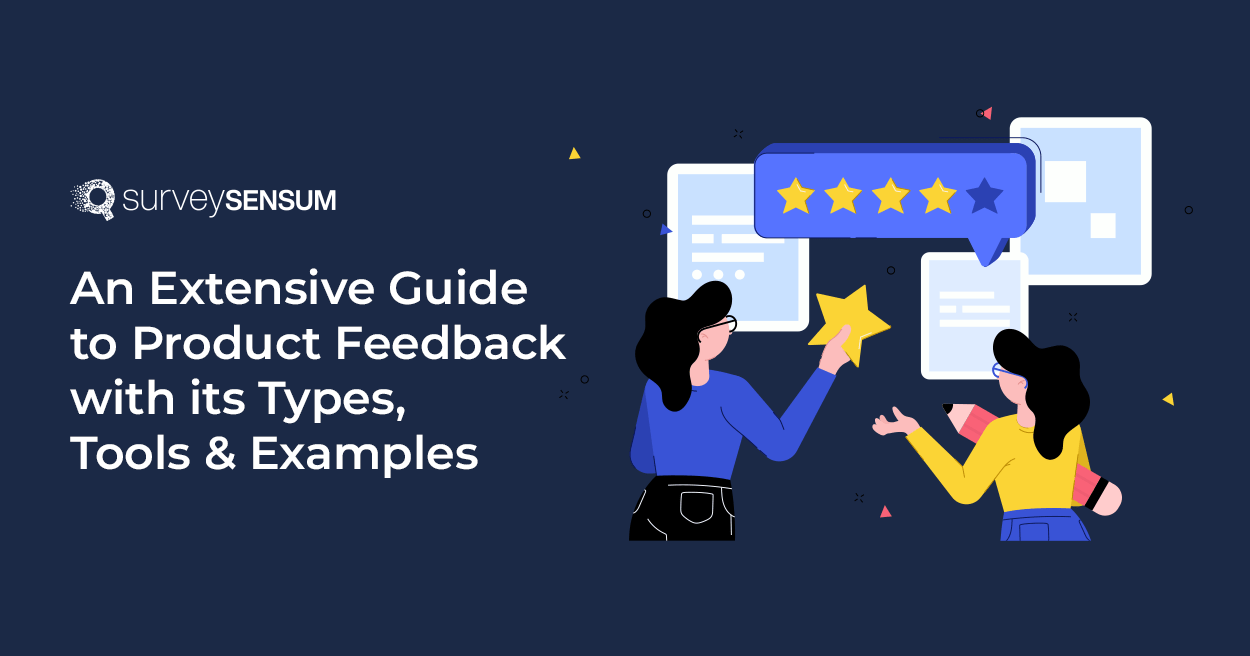In today’s business realm, understanding your product from every single angle is essential. Questions like
→ What is working in your product?
→ What is not working in your product?
→ What should you and your team work on next?
and more hold the keys to innovation and improvement.
But how to unearth these insights?
— By launching product feedback.
This feedback enables you to dive deep into your product to make it better and enhance your customer’s experience. And a robust product feedback platform is the key to it.
But what is product feedback? How to ask it the right way? Or make the best use of it?
You must be having more questions, right?
Hold on because this guide is going to uncover everything about:
So let’s start by understanding what product feedback is.
What is Product Feedback?
Product feedback refers to any feedback and insights gathered from customers and users about a product or service.
Through product feedback, you gain clarity on what resonates with your customers and what falls short. It reveals the critical factors shaping customer satisfaction. Also, “What should we work on next?” becomes crystal clear, as your customers directly inform you about your next steps.
With that, let’s learn why it is crucial.
Importance of Product Feedback
Product feedback is important for several key reasons:
- It helps you improve your product by pinpointing what works and what needs to be better.
- It understands why customers churn allowing you to address issues promptly to retain them.
- By conducting regular SaaS customer feedback you ensure that you’re there for your customers to increase their satisfaction, and build trust and loyalty.
- The gathered feedback improves your product roadmap for future improvements, helping you prioritize areas that need attention.
- Feedback insights can help improve strategies to boost product adoption among potential users.
- Actively using feedback sets you apart in the market by giving you a competitive edge and promoting innovation.
- It enhances your customer-centric approach and builds customer loyalty when customers see their feedback and ideas taken into consideration.
Now that you understand the importance of product feedback, explore product feedback types.
Types of Product Feedback
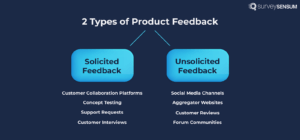
There are two types of product feedback to understand your customer’s expectations better:
- Solicited feedback – that we take from our customers
- Unsolicited feedback – that is voluntarily shared by customers
Let’s dive into each type of feedback in-depth.
1.Solicited Feedback
Solicited feedback involves actively seeking opinions from customers and users to gain valuable insights about your product. You can conduct this type of feedback through various forms such as –
- Customer Collaboration Platforms
Customer Collaboration Platforms involve customers in product co-creation and collecting valuable feedback. They place customers at the core of your business, enhancing engagement, improving the customer experience, and showing customers their input is valued. This includes customer surveys, messaging apps, Slack communities, and social media.
- Concept Testing
Concept testing means sharing new ideas with customers before making them a reality. It’s crucial because it helps you avoid investing in ideas that may not appeal to your target audience. You can do this by gathering feedback through surveys, focus groups, or interviews during the early stages of product development to ensure your concept aligns with customer preferences.
- Support Requests
Support requests are vital channels for customers to share issues and questions about your product, offering real-time insights into their experiences. Using this method regularly helps identify common problems and areas for improvement.
- Customer Interviews
Customer interviews provide qualitative insights beyond numbers, capturing what customers like, and dislike, and how to improve. To use this method effectively, set up interviews that explore customers’ experiences and perspectives. Employ it when you seek a deeper understanding of customer sentiments or when planning feature launches
After knowing everything about solicited feedback, let’s talk about unsolicited feedback.
Analyze Solicited Feedback with Text Analytics!
2.Unsolicited Feedback
Unsolicited feedback refers to feedback spontaneously provided by customers through various channels without direct prompting or requests from a business.
- Social Media Channels
Customers freely share product experiences on social media, like Facebook and Twitter, offering real-time insights into their needs and trends. It offers real-time insights into their expectations, needs, and customer experience trends.
- Aggregator Websites
Aggregator sites like Reddit and Product Hunt host lively product discussions and reviews. Users share candid thoughts and ratings, making it a valuable source of unfiltered user feedback. You can use these platforms to track trends and understand how users view your product
- Customer Reviews
93% of customers read online reviews before buying the product. To harness their influence, use customer feedback in testimonials, turn them into case studies, or showcase them on your website to help potential buyers make informed decisions. This builds trust and credibility.
- Forum Communities
Niche and forum communities act as hidden hubs where like-minded individuals with specific interests gather to discuss and share insights on products. These platforms host discussions related to their focus, enabling you to actively participate, ask customer satisfaction survey questions and directly learn from your customers.
Now that you have the types of product feedback. Let’s move ahead and explore product feedback surveys.
Product Feedback Surveys
In this section, we’ll explore 11 product feedback surveys to gather crucial insights. Each survey type serves specific purposes, is conducted at strategic points, and employs different survey channels to collect feedback effectively.
Here are the following surveys:
- Product Market Fit Survey
- Product NPS Survey
- Product Feature Satisfaction Survey
- Feature Request and Prioritization Survey
- Product Churn/Subscription Cancellation Survey
- Product Review Request Survey
- Free Trial Survey
- Onboarding Survey
- Relationship NPS Survey
- Customer Support Survey
- Prototype Test Survey
Let’s begin with the first survey.
1.Product-Market Fit Survey
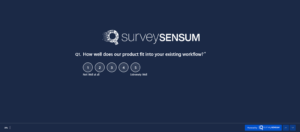
Launch PMF surveys to assess if your product meets market needs. You can conduct this survey early in the product development stages or after a few months of the product launch when the initial group of customers has spent enough time with your product through email, SMS, In-app or In-product, and Chat surveys.
2.Product NPS Survey
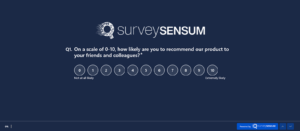
Launching a product NPS survey helps you to understand how likely customers are to recommend your product. So when your customers have used your product thoroughly after purchase or sign-up, then conduct this survey after 90 days via email surveys or in-app pop-ups, email, SMS, and Chat.
3.Product Feature Satisfaction Feedback
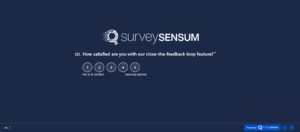
You can gauge customer satisfaction with specific features of your product by launching a product feature satisfaction survey. You can conduct this survey when a new feature has been used for 2-3 days, after major updates, as part of your regular feedback routine, and when feature usage patterns change. You can collect this feedback using in-app or in-product surveys, pop-ups, and chat.
4.Feature Request and Prioritization Survey
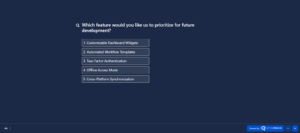
The product team often receives many feature requests. That’s why they use prioritization surveys to decide which ones to work on. Conduct these surveys when feature requests pile up, after major updates, and when new customer feedback trends emerge via online forms within the product, in-app or in-product.
5.Product Churn / Subscription Cancellation Survey

Launch this survey to uncover reasons for customer attrition. Conduct this survey when customers cancel your subscription or stop using your product. Use email, SMS, in-app or in-product surveys, within the cancellation process to send this survey.
6.Product Review Request Survey
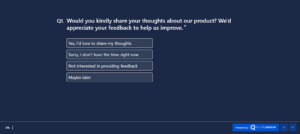
Launch this survey to gather feedback about your product to understand satisfaction, identify areas for improvement, and collect reviews for marketing. It’s typically used after customers have a positive experience with your product. To distribute this survey, you can use common channels like email, in-app prompts, or messages sent via the product’s platform.
7.Free Trial Survey

A free trial feedback survey is sent to gather thoughts from people who tried your product for free. Send this survey after they finish the free trial, often through email or in the app, to make your product even better.
8.Onboarding Survey
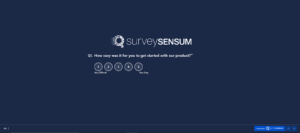
An onboarding feedback gathers the experience of new users with products to refine their experience. You should send this survey after they’ve finished starting within 1-2 days or if it takes longer then send the survey after the first week of regularly using the product, through email, in-app, or in-product surveys.
9.Relationship NPS Survey
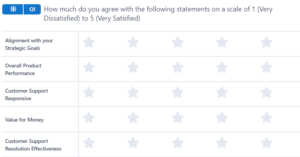
An rNPS survey measures the overall health of your customer relationships. This survey helps businesses understand their customer relationships and loyalty. It’s typically sent through email, and in-app messages, after 6 months to collect insights on how well your brand is perceived and whether customers would advocate for it.
10.Customer Support Survey

Launch a customer support survey immediately after a support interaction to evaluate support quality and identify areas for improvement. You can send this survey through post-support interaction surveys like live chat, helpdesk, phone calls, or email.
11.Prototype Test Survey
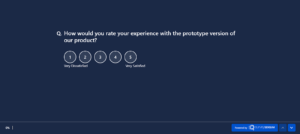
A prototype test survey gathers insights from users who’ve tried a beta version of a product and ensures alignment with expectations. You should send this survey through email or in the app, right after users test the prototype, to make the product better.
And those were the 11 product feedback surveys we just covered. These surveys are best used to collect insights, ensuring you gather feedback at the right times, for the right reasons, and through appropriate channels. This ultimately leads to improving your product and enhancing customer satisfaction.
Create Product Feedback Surveys with SurveySensum
As these surveys will share with you the feedback you are looking for, the question that comes up here is – What to do with this feedback?
That’s where the product feedback loop comes into the picture
The Product Feedback Loop – Turn Product Feedback into Action
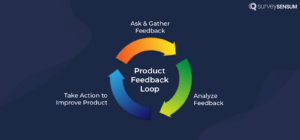
A product feedback loop is a continuous process of collecting, analyzing, and using feedback from users to improve your product.
The loop involves several key steps:
1. Set Feedback Goals and Objectives: Define what you aim to achieve with feedback. Whether it’s enhancing a specific feature or overall product satisfaction, having a clear objective in mind will guide your feedback efforts.
2. Collect Feedback by Asking the Right Questions: Gather product feedback on the SurveySensum platform and use in-built templates to create questions that match your goals to find out what customers like and what can be better.
3. Analyze the Feedback with Text Analytics: Beyond numerical data, analyze open-text feedback to uncover nuanced insights, sentiments, and trends.
4. Link Product Feedback to Customer Data with Segmentation: Segment your customers based on behavioral and demographic data to gain a deeper understanding of their needs. To segment the customers, consider exploring these questions:
- Is the customer new, old, existing, or churned?
- What have they purchased?
- Who is their account manager?
- How often do they use your product?
- What are their NPS ratings (or any other ratings/scores for that matter)?
- Where are they located? (This question can be in terms of high value, low value, or industry-specific)
- How did you acquire them and how much did it cost?
- What are their demographics (if relevant)?
5. Visualize Data: Use charts and graphs to help users understand the insights better.
6. Align Insights and Stakeholders and Share Forward: Make sure the right teams and stakeholders know what you find. This builds a customer-centric culture.
7. Aim for Continuous Improvement: Use the gathered feedback efficiently to make changes and keep making your product better for customers.
This is how you create a strong product feedback loop, collect insights, and use them to keep improving and make customers happier.
Improve Product Adoption with Customer Feedback
With that let’s explore our next section covering the checklist of the product feedback automation process.
Product Feedback Automation Checklist
Product feedback automation is a game-changer. It ensures you consistently collect feedback, manage tasks efficiently, and boost customer retention. This means you save time, resolve issues faster, and make customers happier. This is where SurveySensum comes in as it provides essential automation features for user surveys and feedback management.
So without much ado, check out this checklist of product feedback automation processes that save you time and ensure that you can effectively manage vast feedback processes, including
1. Customer Segmentation

The product feedback tool should have advanced segmentation techniques to categorize feedback based on your customer attributes, behaviors, and demographics. This enables personalization, targeted marketing, and data-driven decision-making, ultimately leading to improved customer relationships and business success.
For instance, you can create customized segments, such as “New Customers” or “High-value Users,” and tailor feedback surveys to each group for more relevant insights on the SurveySensum platform.
2. Website Intercept
The platform should allow you to trigger feedback surveys based on specific user interactions or events on your website.
For instance, with SurveySensum, you can automatically prompt users to provide feedback on the popup survey after they use a new feature update, ensuring timely feedback collection.
3. Multichannel Feedback
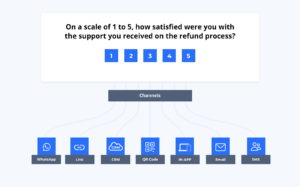
Your feedback tool should offer multi-channel feedback collection, enabling you to gather insights from various touchpoints. This versatility is crucial for a holistic view of customer feedback, as it allows data to be collected from different sources and interactions, providing a more comprehensive understanding of customer sentiment and preferences.
For instance, SurveySensum collects feedback through in-app surveys, WhatsApp surveys, email, web intercepts, and even SMS, and more ensuring that feedback collection aligns with customers’ preferences.
4. Workflow
The platform should streamline feedback workflows by automating tasks like survey distribution, response collection, and result analysis. This helps you launch surveys after an event triggers, sends surveys at the right time, and asks the right questions.
For instance, SurveySensum provides customizable workflows to automate follow-ups, ticketing, and escalation processes, ensuring that feedback actions are streamlined and efficient.
5. Integration
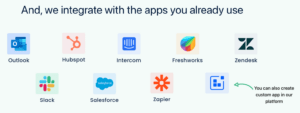
It should seamlessly integrate with various CRM, project management, and analytics tools to ensure better customer data management, streamlined projects, and data-driven decisions, leading to improved business operations and customer satisfaction.
For instance, if you use Salesforce, HubSpot, or Slack then you can trigger surveys with SurveySensum integration, making it easy to track and act upon customer feedback.
6. Survey Throttling
While surveying, you should not overwhelm your customers with too many survey requests because that leads to survey fatigue. That’s why you should have survey throttling in your product feedback tool. With this you can schedule surveys at specific intervals or after certain events, improving response rates.
For instance, SurveySensum enables feedback throttling, allowing you to control the frequency and volume of customer feedback requests.
By leveraging SurveySensum’s capabilities, you can automate the entire feedback process, from collection to analysis and action.
To Sum Up,
Now that you know everything about product feedback from its types to the entire automation process, make sure you select the best product feedback tool for your business as per your requirements. Platforms like SurveySensum simplify the feedback process making it more accessible to gather and analyze feedback effectively.
Remember that embracing feedback is not just a strategy; it is a commitment to truly understand and serve your customers better. Whether you aim to refine your product, gather insights, or enhance your services, this journey promises a brighter future for both your product and your customers.






